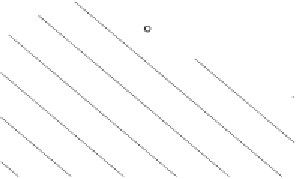Geoscience Reference
In-Depth Information
3 Gravity reduction
3.1
Introduction
Gravity
g
measured on the physical surface of the earth must be distin-
guished from normal gravity
γ
referring to the surface of the ellipsoid. To
refer
g
to sea level, a reduction is necessary. Since there are masses above
sea level, the reduction methods differ depending on the way how to deal
with these topographic masses. Gravity reduction is essentially the same for
gravity anomalies ∆
g
and gravity disturbances
δg
.
Gravity reduction serves as a tool for three main purposes:
•
determination of the geoid,
•
interpolation and extrapolation of gravity,
•
investigation of the earth's crust.
Only the first two purposes are of a direct geodetic nature. The third is of
interest to theoretical geophysicists and geologists, who study the general
structure of the crust, and to exploration geophysicists.
The use of Stokes' formula for the determination of the geoid requires
that the gravity anomalies ∆
g
represent boundary values at the geoid. This
implies two conditions: first, gravity
g
must refer to the geoid; second, there
must be no masses outside the geoid (Sect. 2.12). Hence, figuratively speak-
ing, gravity reduction consists of the following steps:
1. the topographic masses outside the geoid are completely removed or
shifted below sea level;
2. then the gravity station is lowered from the earth's surface (point
P
)
to the geoid (point
P
0
, see Fig. 3.1).
P
earth's surface
H
geoid
P
0
Fig. 3.1. Gravity reduction


